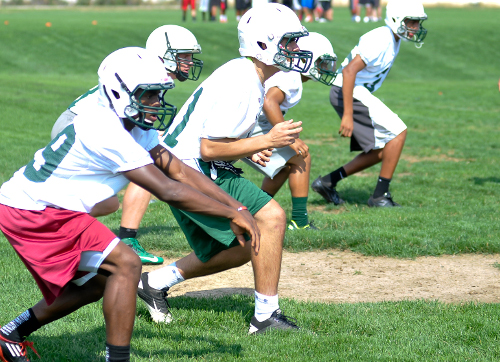Five Pillars of Exertional Heat Stroke Prevention
By NFHS, Korey Stringer Institute on August 31, 2015 blog Print
As high schools' fall seasons kick into high gear across the country, summer weather has not quite given way to cool fall temperatures. Heat stroke is still a major concern for student-athletes participating in outdoor sports. It is also the single-most preventable risk.
It is imperative for coaches and trainers understand and recognize the causes and signs of heat exhaustion. Below, the Korey Stringer Institute lists its five pillars of heat stroke prevention.
Hydration
- Maintaining appropriate levels of hydration prior to, during, and post exercise will assist in attenuating large increases in core body temperature during intense exercise in the heat.
- To decrease the risk of exertional heat stroke, athletes are encouraged to minimize fluid losses during exercise. Fluid needs are individualistic depending on an athlete’s sweat rate and a specific rehydration plan should be in place for every athlete
Body Cooling
- Body cooling can be an effective means of attenuating the rise in core temperature and can be done pre-exercise, during exercise, and post-exercise.
- There are a number of cooling modalities that can be effective in assisting to keep the body cool during exercise in the heat and are applicable to most sports settings (equipment laden sports, sports with minimal or no rest time during activity, etc.).
- For the equipment-laden athlete/laborer/soldier that may be at great risk of exertional heat stroke when exercising in the heat, a specific plan for utilizing cooling during rest breaks is imperative.
Work to Rest Ratios
- Having appropriate work-to-rest ratios (the amount of time spent involved in exercise versus the amount of time spent in recovery) should be modified as environmental conditions become extreme.
- Environmental extremes should be measured using wet bulb globe temperature (WBGT). WBGT takes into account ambient temperature, relative humidity and the radiation from the sun to give an accurate measure of the heat stress that the athlete will be experiencing during exercise in the heat.
- Modifications of work-to-rest ratios in extreme environmental conditions include increasing the number of rest breaks, the duration of rest breaks, and having unlimited access to hydration.
Acclimatization
- Having athletes go through a heat acclimatization protocol at the start of exercise in the heat is one of the best ways to help in preventing exertional heatstroke.
- Heat Acclimatization is a series of physiological adaptations the body uses to tolerate exercise in the heat and occurs over a period of 10-14 days.
- To have the full effects of the adaptations that heat acclimatization allows, it is imperative that athletes maintain an appropriate level of hydration.
Education
- Athletes, coaches, parents, athletic trainers, and other medical professionals should all be educated on the proper preventative strategies to prevent exertional heat stroke. Proper education will minimize the risk and incidence of exertional heatstroke.
- Having proper education and knowledge of the signs and symptoms are also imperative to ensure appropriate treatment in the event of an athlete suffering from exertional heatstroke.
- If medical care is present and exertional heat stroke is suspected - cool first, and then transport second to ensure appropriate treatment.
- If no medical care is available and exertional heat stroke is suspected, immediately active EMS (911) and begin cooling the athlete. For cooling, immerse the athlete in whole body cold-water immersion, which is the gold standard for cooling the exercising athlete.
NFHS, Korey Stringer Institute
Most Recent Articles
- nfhs news NFHS Learning Center Unveils School Honor Roll Program
- NFHS Network Contact Information
- nfhs news Shout-out to Health-Care Workers and State High School Associations
- state news Stadiums Across Colorado Light Up to Show Support for Students
- gymnastics-girls article ‘They became a family’: How New Castle gymnastics qualified for state for first time since 2002



